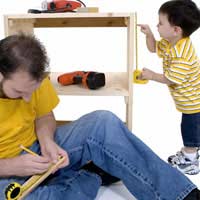Spatial Awareness in Young Children

Spatial awareness is an organised knowledge of objects including oneself, in a given space. Spatial awareness also involves understanding the relationships of these objects when there is a change of position. Obviously this is complex mental skill, one that children must hone from a young age. Spatial awareness should come naturally to most children, though there is much that parents can do to promote special awareness.
Spatial Awareness
Spatial awareness is usually defined to include a person, so that for a child to have spatial awareness, that child will understand his/her location and the location of objects in relation to his/her body. In understanding these relationships, children come to learn concepts such as direction, distance and location. For example, a child with spatial awareness will understand that as (s)he walks towards a football, the football is becoming closer to his/her own body. Children tend to naturally develop a sense of spatial awareness, as parents will often observe. At a most basic level, parents can watch infants throw their arms wide even when they are being held by someone. As the child grows, his/her arm movements will likely become more restrained when (s)he knows that others are close by.Promoting Spatial Awareness
The key to promoting spatial awareness in children is to allow them to explore their surroundings. As children become more mobile, they are able to crawl and later walk to objects and gain for themselves an understanding of how many steps it takes them to reach a given object or a given location. When children are able to move themselves they will also come to understand how their location to objects changes as they move. However, there are still a number of ways that parents can help promote spatial awareness in young children, including:- Discussing locations. For example, leaving a toy on the bed and talking about where the toy is, where the bed is, where the bedroom is, etc.
- Using comparative terms. For example, mentioning which objects are closer and which objects are farther from a child’s current location.
- Talking about relationships. For example, showing a child that a book is under a chair or that a video is on top of the shelf.
- Measuring distances. For example, making a game out of how many paces it takes to walk the length or width of the back garden.
- Giving directions. For example, asking a child to turn left at a tree or to open the door on the right. Young children could also be asked to raise their left arm or wiggle their right foot.
Spatial Awareness and Disabilities
Children who do not naturally develop spatial awareness may have a physical or learning disability that is precluding this development. For example, Asperger’s Syndrome and Dyspraxia both often manifest a lack of spatial awareness. Sometimes this can be seen in children who appear clumsy, can not follow instructions or directions and can not tell his/her left from right.Spatial awareness allows children to understand their location and the location of objects in relation to their own bodies. Most children naturally develop spatial awareness as they explore the world and engage in play. Parents of a child approaching school age who are concerned about their child’s spatial awareness should consult a GP, educational or childcare expert for further information.


Re: Speech Therapy for Children
Dear Speech Therapy Clinic, I am writing to inquire about speech therapy services for my 3-year-old son. I have noticed that he…
Re: Child Temper Tantrums
I often use my book center for a calm down center. It is not a punishment but a place to take a break and calm down quietly
Re: Mahler's Theory of Development
I'm learning a lot about the end theories .
Re: Child Temper Tantrums
As an assistant director, I get brought kids who the teachers are struggling with to help calm them down. I bring them into my office, we…
Re: Brain Development in Young Children
Hi I have a son. He is 2 and half years old and he is diagnosed with autism. He doesn’t respond to his name and appears…
Re: Child Temper Tantrums
i think once you start to learn the child handling their behavior is easier. it takes time but patience is a virtue!
Re: Erikson's Theory of Psychosocial Development
No, children develop in their own pace for example, a 1-year-old would develop to hold a pencil and another…
Re: Extra Tutoring: How Do I Pay?
i am looking to help out students with private tuition as their parents cant afford it i would like to apply for grants or…
Re: The 'Terrible Twos'
child throws temper tantrum when its cleanup time even when singing the cleanup song, hits my hand and starts pulling the toys back out of the…
Re: Child Temper Tantrums
we work with 5 year olds to 12 year olds.We try to tell the kids what are the basic rules the first day of school.We call them friends from…